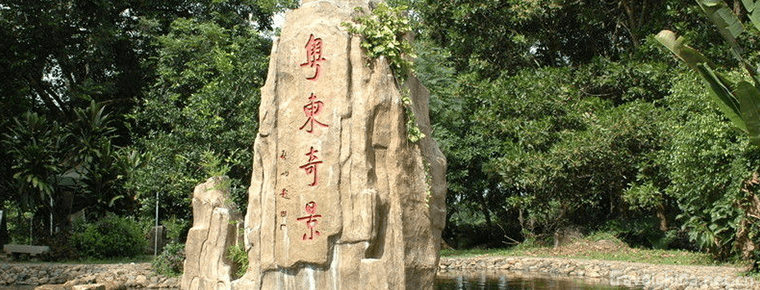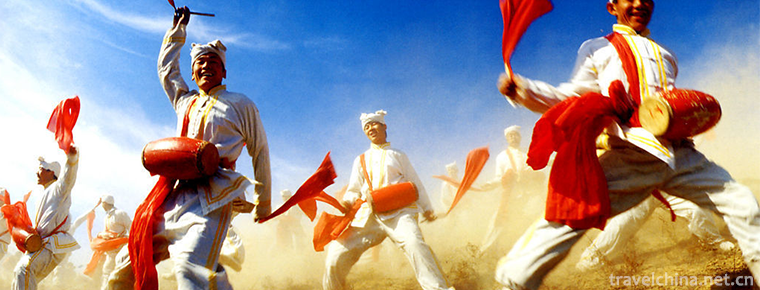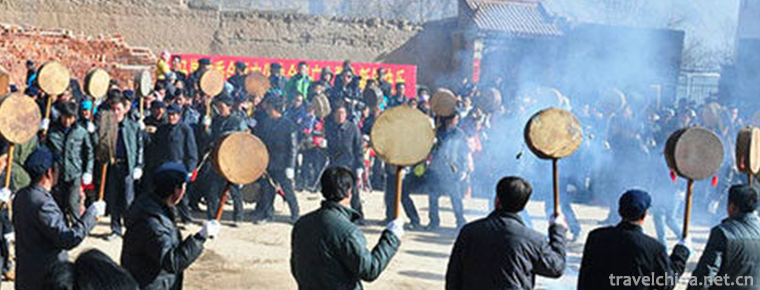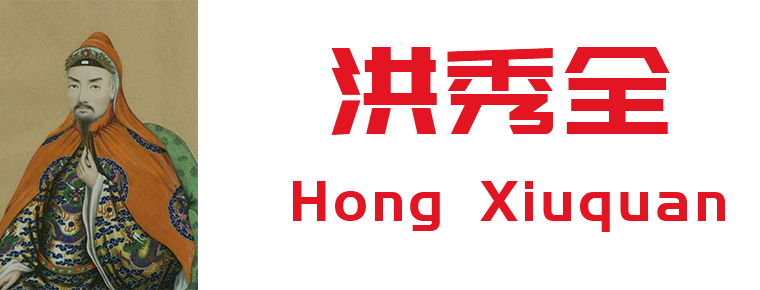Wooden drum dance
Wooden drum dance
Wood drum dance is one of the national intangible cultural heritage in Taijiang County of Guizhou Province and Cangyuan Wa Autonomous County of Yunnan Province.
Wood drum dance is a kind of folk dance that is spread among the Miao, Yi and Wa people in southwest China to dance and sacrifice by beating wood drum. Its drum shape is mostly to intercept the trunk of naturally growing trees and hollow out the internal shape. Generally, wood drum is a part of the large-scale sacrificial activities in which all ethnic groups participate. The wood drum is regarded as the symbol of the ethnic group. The sacrificial activities centered on beating and jumping wood drum are full of strong ancestor worship and natural worship, and have distinct characteristics of primitive culture.
On May 20, 2006, Wood Drum Encouragement was approved by the State Council to be included in the first batch of national intangible cultural heritage catalogues, numbered III-25.
historical origin
Wood drum inspiration originated from a pair of ancient brothers and sisters who learned to dance with birds and insects. Since ancient times, anti-row timber drum inspiration has been handed down from generation to generation in anti-row village.
At the beginning of the creation of heaven and earth, a huge flood devoured almost all lives on land. It was Muyiji who saved a wooden trough from the Wa people, and only then did the Wa people multiply and grow and survive to this day. From then on, the Awa people in ancient times regarded the wooden trough as the mother of the nation and gave it the highest worship. Awa people believe that the wooden drum is not only the trough that saved the ancestors of their own race, but also the incarnation of a strong mother, and the residence of Muyiji's soul. It has become a god-like instrument for the flourishing growth of all things. Therefore, it is an indispensable dance in sacrificial activities to express it in the form of dance, from the production of wooden drums to the communication of gods by beating wooden drums to achieve the purpose of God's blessing.
Since the beginning of the Tang Dynasty in 1954, Zhang Wenxian and others adapted the anti-row timber drum and performed in Beijing, there have been more than 100 anti-row timber drum performances.
On June 20, 1995, the State Council formulated and issued the Outline of the National Fitness Program in order to better carry out mass sports activities and enhance people's physical fitness. As a long-standing national mass activity in Anti-row Village, wooden drum encouragement requires less venues and props. It can promote the blood circulation, improve the flexibility and coordination of the body, and enhance the basic activity ability and physique of the human body.
In 2009, Taijiang County had a population of less than 150,000 people, of which more than 20,000 people would dance back-row timber drum.
In the 10s of the 21st century, the anti-platoon area of Taijiang County almost opened a new chapter for the people to dance wooden drum.
Inheritance and Protection
Inheritance value
Reverse row timber drum inspires unrestrained and vigorous, fierce and heroic, enthusiastic and unrestrained, showing the stubborn temperament and strong vitality of the Miao people in mountainous areas. She is the cream of Miao dance and a living fossil of Miao cultural activities. It is a wonderful flower of the world's national culture.
Anti-row village is rich in national cultural resources. In the 10s of the 21st century, the Miao cultural ecosphere with the main cultural characteristics of anti-row timber drum is still preserved. Reverse row timber drum dance is an important part of the Miao Drum Festival activities, or an important cultural link linking the Miao society.
Wooden drum is the God of heaven in the legend of the Wa people. It is regarded as the source of ethnic reproduction and the historical and cultural symbol of the Wa people. Wood drum dance embodies the achievements and characteristics of Wa folk songs and dances, literature, art and religious beliefs. It not only has high artistic value, but also has certain research value in art, ethnology, folklore and religion. Wood drum dancing is a master of Wa folk songs and dances, has become a pearl in the wooden drum culture that Wa people take pride in, is the most intuitive and vivid embodiment of Wa culture, has been loved by the majority of Wa people. Every festive day, people always dance wooden drum to express their joy. Wood drum has become a diligent, brave, united, enterprising and pioneering people of the Wa people. The symbol of national spirit plays an irreplaceable role in the cohesion of its national spirit.
Current situation of inheritance
Due to historical limitations, some villages have basically lost their heritage, and the existing prominent ones are anti-row timber inspiration, Shidong timber inspiration and Gedong timber inspiration. The two kinds of dances differ from the production of wooden drums to the beating of drums and dance movements, each having its own merits.
With the development of history, the consciousness and concept of Wa people have changed dramatically. The new scientific culture has replaced the feudal superstition in the old society. However, as a traditional sacrificial work, Wood Drum Encouragement has not disappeared. It has become a form of amusement dance recognized and loved by Awa people with a brand-new look that does not lose the traditional national style.
Heritage figures
Wan Zhengwen, male, Miao, born in Taijiang, Guizhou in 1951. The second batch of national intangible cultural heritage projects, Wood Drum Encouragement (anti-row Miao Wood Drum Encouragement), are representative successors.
Chen Jiebao, male, Wa nationality, born in May 1939, was named the representative successor of the fourth batch of national intangible cultural heritage Cangyuan Wa Mugu Encouragement List in December 2012.
protective measures
In order to build the Wa Mountain cultural characteristic county in Ximeng and promote the local wooden drum culture, the Wa Autonomous County of Ximeng holds the International Wa Drum Festival from April 13 to 15 every year under the name of "wooden drum", as an important measure to develop the Wa Mountain national culture in Ximeng.
In May 2006, Taijiang County Anti-row Wood Encouragement has declared as a national intangible cultural heritage. At the same time, Taijiang County Anti-row Village has declared as a national intangible cultural heritage protection unit. Some nearby villages have also successfully declared provincial or state-level non-heritage protection units.
social influence
Important Exhibitions
In 1990, the Anti-row Wood Drum Encouragement Team performed in Zhongnanhai, which was favored by Jiang Zemin, Yang Shangkun and other party and state leaders. Later, it performed in more than ten countries and regions, such as Britain, the United States, Canada and Italy. It was known as the Oriental Disco and was well-known overseas.
On April 30, 2015, the Cangyuan Wa Wood Drum Encouragement Competition, a series of activities of the "Black Carnival" in Sigangli, Wa Nationality of China, was held in the "Black Culture Plaza" in Cangyuan Wa Autonomous County, in which the "Wood Drum Encouragement" was displayed.
Honorary recognition
The collective dance "The Sound of Wooden Drums Towards Beijing", created and performed by the Wengong Team of Cangyuan Wa Autonomous County, won the third prize for excellent program creation in Yunnan Province from October 1976 to December 1978.
On May 29, 2018, the first Zhejiang Folk Art Exhibition and the seventh Zhejiang Folk Literature and Art Yingshan Red Award-Excellent Folk Art Performance Selection Activity were held in Fenghua Stadium. The She Wood Drum Encouragement of Anji County was awarded the seventh Zhejiang Folk Literature and Art Yingshan Red Gold Award.


-
Maiji Mountain Scenic Spot
Maiji Mountain, located in Maiji District of Tianshui City, Gansu Province, is a lone peak of Xiaolongshan, 142 meters high, named for its resemblance to wheat stacks.
Views: 126 Time 2018-12-12 -
Liupanshan National Forest Park
Liupanshan National Forest Park is located in the center of the triangle formed by Xi'an, Yinchuan and Lanzhou. It is located in the south of Ningxia. It spans two counties and one district in Jingyua.
Views: 121 Time 2018-12-24 -
Helan Mountain Rock Painting
Helan Mountain Rock Painting is a national key cultural relics protection unit, the national AAAA level tourist attractions, the national research tourism demonstration base (2016 one of the first 20).
Views: 97 Time 2019-01-13 -
Green Island Tourist Villa
Green Island Tourist Villa is one of the eight new scenic spots in Chaozhou, the national demonstration sites of leisure agriculture and rural tourism, the base of science and technology.
Views: 104 Time 2019-02-06 -
Ansai waist drum
Ansai waist drum is a traditional folk dance in Shaanxi Province. Performances can be performed by several people or thousands of people together, magnificent momentum, exquisite performance is intoxi.
Views: 229 Time 2019-03-31 -
Badang dance
Badang Dance is a kind of ancient folk dance, which originated from the ancient Qiang people's "Temple Festival" in Dingxi Minxian, southeastern Gansu Province. It is also a sacrificial ritu.
Views: 189 Time 2019-04-02 -
Changzhou comb
Comb, also known as Chlamys, is one of the eight hairdresses in ancient China. It is a local traditional handicraft with a long history in Changzhou City, Jiangsu Province..
Views: 255 Time 2019-04-16 -
Dong Pipa Song
Dong Pipa song is distributed in the southern dialect area of Dong nationality, which can be divided into lyric and narrative Pipa song. Its singing content almost covers Dong history.
Views: 117 Time 2019-04-28 -
Running curtain
Running curtain originated in the Spring and Autumn Period and Warring States Period, formed in the Qin and Han Dynasties, flourished in the Song, Yuan, Ming, Qing Dynasty and the early Republic of Ch.
Views: 332 Time 2019-06-09 -
Jumping vegetables of the Yi nationality
The dance accompaniment of the Yi nationality is "Dance dishes", which means serving dishes by dancing. It is a unique form of serving and the highest etiquette of banquet for Yi people in W.
Views: 148 Time 2019-07-12 -
Hong Xiuquan
Hong Xiuquan (January 1, 1814 - June 1, 1864) was famous for his show. In order to avoid God's "Huo Huo Hua", Jehovah "Homonym" has been changed to the present name, the founder of.
Views: 202 Time 2019-09-07 -
Resources and environment of Leshan
By the end of 2018, the total energy consumption of Leshan City was 15.3994 million tons of standard coal, an increase of 580900 tons of standard coal over the previous year. The energy consumption of 10000 yuan GDP decreased by 4.38%..
Views: 144 Time 2020-12-17











